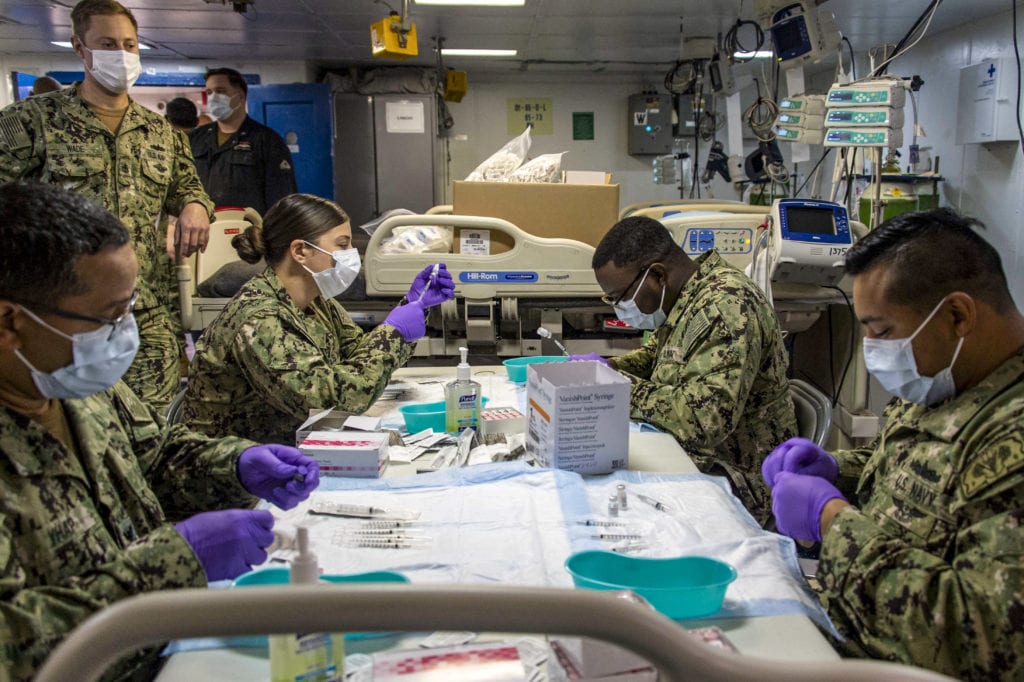
ARLINGTON, Va. — The U.S. Navy’s newest operational guidance for dealing with the coronavirus pandemic includes provisions for more Safe Haven ports like Guam and Rota, Spain to provide secure liberty opportunities for crews on increasingly lengthy deployments, according to senior officers.
COVID-19 Standardized Operational Guidance (SOG) 4.0 is the first directive for commanders since vaccines against the novel coronavirus became available in January. Although predominantly focused on shipboard environment, SOG 4.0 applies to all uniformed Navy personnel at home and deployed.
Fully immunized Sailors enable the Navy “to begin to unwind the limits” placed on Sailors at sea, where the consequence of a wide-spread outbreak is greatest, the Guidance issued Feb. 16, noted.
“Where a ship at sea can be a challenge to contain the spread, having a high immunization rate [among crew] could cause the disease to have nowhere to go and burn itself out,” Rear Adm. Karl Thomas, Assistant Deputy Chief of Naval Operations for Operations, Plans, and Strategy, (N3/N5B), said Feb. 19.
In a roundtable with reporters, Thomas said 35,000 Sailors have received at one vaccine injection and 45,000 are totally immunized. Rear Adm. Bruce Gillingham, the Surgeon General of the Navy, said those numbers amounted to about 23% of the Fleet having at least one dose of the vaccine. Whether immunized Sailors can still transmit the virus remains “the $64,000 question,” Gillingham said.
Since a COVID outbreak in early 2020 infected more than 1,000 crew members of the USS Theodore Roosevelt and sidelined the aircraft carrier at Guam for months, deployed ships have spent nearly all their time at sea. Additionally, increased operational tempo has led to longer deployments and quick turn arounds, or double pumps, for carrier strike groups, causing stress for crews and their families. The carrier USS Dwight Eisenhower, at sea for seven months in 2020, was deployed again in February.
“Up until this point, we’ve really had to restrict the Sailors to liberty on the pier,” Thomas said, adding. “In Guam there’s a beach right next to the pier and we’re able to keep it segregated from the population so they can get some liberty on the pier as well as get down to the beach.”
But in SOG 4.0, he said “we actually put a paragraph in there about Safe Haven ports in places like Guam, Yokosuka, Bahrain.” Officials hope that crews with higher immunization rates will be able to have more quality liberty opportunities at ports with more services like Exchanges and Morale, Welfare and Recreation facilities.
The final decision on safe haven ports will be up the geographically dispersed Navy component commanders “but we wanted to put [the opportunity] into the guidance for them to be able to do that type of thing,” Thomas said.
- Shall We Play a Game? Winning Isn’t the Point, Experts Say - April 5, 2023
- U.S. Goal: Maintaining Extended Presence in Arctic’s Harsh Environment - April 4, 2023
- Joint, Combined Exercise Shows Marine Littoral Regiment Idea is on ”Right Track’ - February 24, 2023






